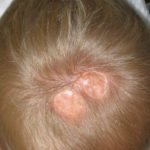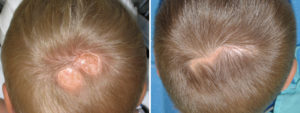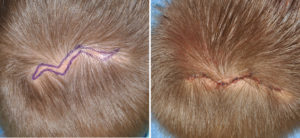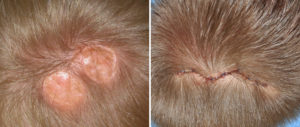Background: The scalp is not prone to a lot of different congenital conditions. But one congenital abnormality that does occur is that of cutis aplasia. This is a condition where there is an absence of skin and deeper structures underneath it including bone in some cases. While it can occur anywhere on the body, it commonly occurs on the scalp. In my experience I have seen it numerous times over the vertex of the skull and appears as circular patches.
While cutis aplasia can occur as part of numerous syndromes, its non-syndromic appearance is that os isolated skin lesions. In some cases they appear at birth as open areas that go on to heal with a thin epithelial cover. In other cases the missing skin areas have already healed at birth.
Reconstruction of the scalp cutis aplasia involves lesion excision and scalp flap coverage. Because of the natural tightness of the scalp, which is like skin stretched over a large ball, either large rotation scalp flaps have to be raised or scalp tissue expansion used.




Case Highlights:
1) Cutis aplasia is a congenital skin defect that frequently involves the vertex of the scalp
2) Excision of the scalp lesions requires hair-bearing skin coverage.
3) Tissue expansion is one method to increase the availability of hair-bearing scalp without making long additional scats to raise rotational scalp flaps.
Dr. Barry Eppley
Indianapolis, Indiana


